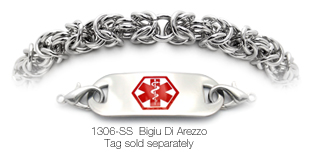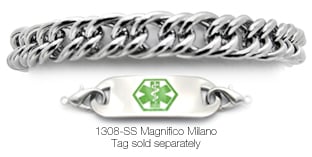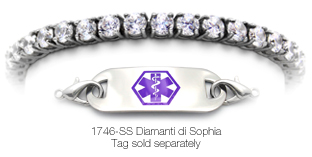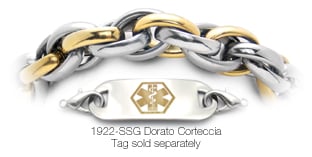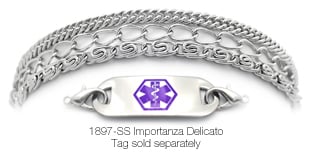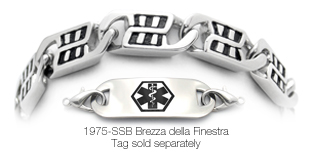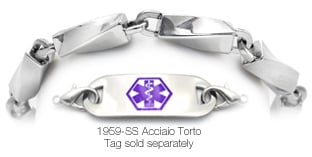Check first so you know which bracelet to buy
Your body Is making a statement: If you find your skin breaking out with a rash when you wear a metal medical ID bracelet, or any type of metal jewelry, you may have a metal allergy. Symptoms include bumps on the skin, itching, redness or changes in skin color, dry patches of skin, or blisters. Luckily, you’re not alone and there are some solutions.
Does that sound like you? Metal allergies affect about 17% of women and 3% of men within the general population. Those who already have problems with dermatitis, which is general inflammation or irritation of the skin, are more at risk to developing a metal allergy. If you have a family history of metal allergies you will also be more susceptible to developing it yourself.
Stainless steel, a stylish option: On this page you'll see a variety of designs that have been missing from stainless steel medical ID bracelets for decades. Because most stainless steel bracelets at drugstores and other medical outlets look like "dog chains" or "hospital bracelets"…lacking style and creativity…most people with serious medical conditions are simply not wearing anything because it looks embarrassing, ugly and just plain boring. This small sampling is from our vast design array from our stainless steel product page to help demonstrate that stainless steel is a lot more than you may have ever imagined.
The culprits behind the reaction: Most people with metal allergies have reactions to nickel or nickel alloys. Even though nickel allergy is considered to be the most common, there are many people who are allergic to many other metals such as brass, bronze, palladium, pewter, cadmium, chromium, cobalt or zinc. Surprisingly, even what’s considered safe such as precious metals like gold, silver, rhodium or platinum can also problematic. So the short answer is that you can be allergic to any metal.
Before you jump the gun, look below the surface: There are many who appear to be allergic to gold, silver, rhodium or platinum, when it’s what’s mixed-in or found below those precious metals that’s the culprit. It’s typical that these individuals are allergic to the nickel present in or below the metal after the, gold, silver, rhodium or platinum tarnishes or wears away.
Fashionable remedies: Because Medical ID Fashions sells fine designer jewelry, it’s important to have options for customers with metal allergies. We usually recommend using our medical grade stainless steel ID plates and chains. And for beaded fashion bracelets that mix precious stones with pewter, brass and zinc — substituting stainless steel for these metals is typically an effective remedy.
What makes it strong can hurt: Even medical grade 304 stainless steel contains trace metals such as nickel and cadmium. Although, without the help of these trace metals stainless steel wouldn’t be so tough. What’s more, surgical 316 stainless steel has even higher levels of nickel and cadmium than 304. However, for most people, these trace metals are so tightly bound molecularly that it doesn’t leach out to affect them. Even so, some people are so sensitive to nickel and cadmium that even stainless steel is ruled out.
When stainless steel fails: Wearing our all-bead glass or precious stone styles is the best way to avoid any metals. For some people, just wearing bigger stone or glass beads prevents the metal “findings” from touching your skin. This can be another way to live with some metals. Special modifications are possible to accommodate our customers with allergies. These include using epoxy coatings on ID tags and other metal surfaces.
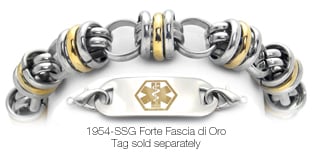
Allergy or dirty bracelet? You’d be surprised how many customers get rashes due to dirty bracelets. To rule out metal allergies, please take off your chain or metal beaded bracelet on a weekly basis to first cleanse the skin immediately below the bracelet, and then clean the bracelet itself.
Different bracelets require different cleaning: 1. For Designer Stainless Steel or Precious Metal WaterWear Bracelets®, wash and soak your bracelet in diluted and mild Dawn dishwashing liquid. Once clean, wipe dry with a clean, soft cotton cloth. 2. For Beaded Fashion Bracelets—Do Not soak in water or use any chemicals. Only use a soft cloth slightly dampened with water to carefully wipe the bead surfaces. Then use another clean and dry soft cloth to carefully dry the bracelet parts.
Clean carefully: When cleaning your bracelet, don’t forget to clean your ID plate at the same time. You can clean it with diluted and mild dishwashing liquid along with your Metal Bracelets. If you have a Fashion Beaded Bracelet (which cannot go into water), the ID plate needs to be cleaned separately with either dishwashing liquid (as above) or wiped with alcohol using a soft cotton cloth. Do not immerse in water and keep the stainless steel wires dry. Make sure to dry it before wearing.
Avoid Irritation: To prevent from having a reaction while wearing your bracelet, keep your wrist dry. Since you will be wearing it most of the day, you’ll want to take extra precaution to keep your skin dry after showering, swimming, washing your hands, or when outdoors.

